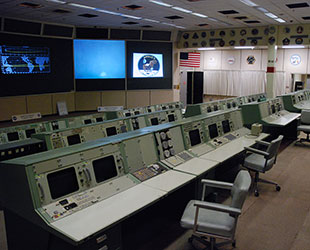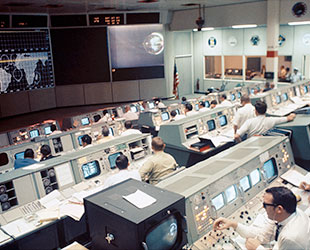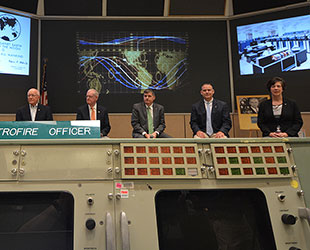June 4, 2015 – NASA's historic Mission Control is soon to be made even more historic.
The agency's original control room in Houston, which first went active 50 years ago Wednesday (June 3), has been dormant since 1992. A National Historic Landmark, today it is a public tour stop and features the authentic consoles used for the Apollo 11 moon landing and Apollo 13 in-flight emergency, among 40 other space missions.
Now, a restoration effort is getting underway to make sure the room is around for many generations to come.
"It is a place that feels like a cathedral to us," said Apollo-era flight director Glynn Lunney on Wednesday at a press event held in the control room to mark its first 50 years. "I think we would like to see it permanently [preserved]."
"I think it is important for people to come to see it. I hope they are going to be seeing it a hundred years from now," he added.

NASA's Historic Mission Control room, a National Landmark, will be restored to its 1972 state at the end of Apollo. (collectSPACE) |
Similar flight control rooms inside the same building, the Christopher C. Kraft, Jr. Mission Control Center at NASA's Johnson Space Center, have been — and continue to be upgraded — to support the crews aboard the International Space Station, future commercial crewed spacecraft and the space agency's own planned Orion missions into deep space.
The "Historic Mission Control Room," as its name implies, has generally been left in an Apollo configuration, although there is room for improvement.
"NASA has involved some of us old guys to participate in the restoration of this thing," Gerry Griffin, an Apollo flight director and former director of the Johnson Space Center, said. "The idea is to perhaps put it back exactly like it was the last day we walked out of here in 1972 at the end of Apollo. That's kind of the vision."
The specifics of the restoration were not discussed, but if left to Griffin, it will include the minor details that gave the room its iconic character.
"The ashtrays have got to be there," Griffin told reporters, adding the coffee cups, too.

Mission Operations Control Room-2 (MOCR-2) in 1969. (NASA) |
The restoration plan, which was said to still be in its early stages, is intended to be complete by July 2019.
"This effort is timed for the 50th anniversary of the Apollo moon landing," stated Norm Knight, chief of NASA's Flight Directors Office.
"We can feel the ambiance in this room, because whether on the moon or on Apollo 13, this is where it all started, this is the foundation," Knight reflected. "Everything that's being built on today began on the shoulders of the giants who worked in this room. And that is important."
"When you come into this room, you'll be able to learn and understand what these giants did in that timeframe — and then see where NASA is going in the future," he said.
The project, which involves the National Park Service, is on track, said Knight.

Flight directors (left to right) Gerry Griffin, Glynn Lunney, Steven Stich, Norm Knight and Holly Ridings participate in a media event for 50 years of Mission Control Houston. (collectSPACE) |
"Of course, it is a National Historic Landmark and we are going through the process of looking at everything that's in here, seeing how to improve it or upgrade it while retaining the historical value of what people come here to see," said Lunney.
The restoration has the support of the mission controllers who used the room, not just during its start 50 years ago, but also throughout its history.
"This room represents Gemini, it represents Apollo, and it represents shuttle — we did fly shuttle flights from here," said shuttle-era flight director Steve Stich, who worked his first mission out of the same room when it was active. "I love it the way it is. If we can make it a little bit better, it would be great."
